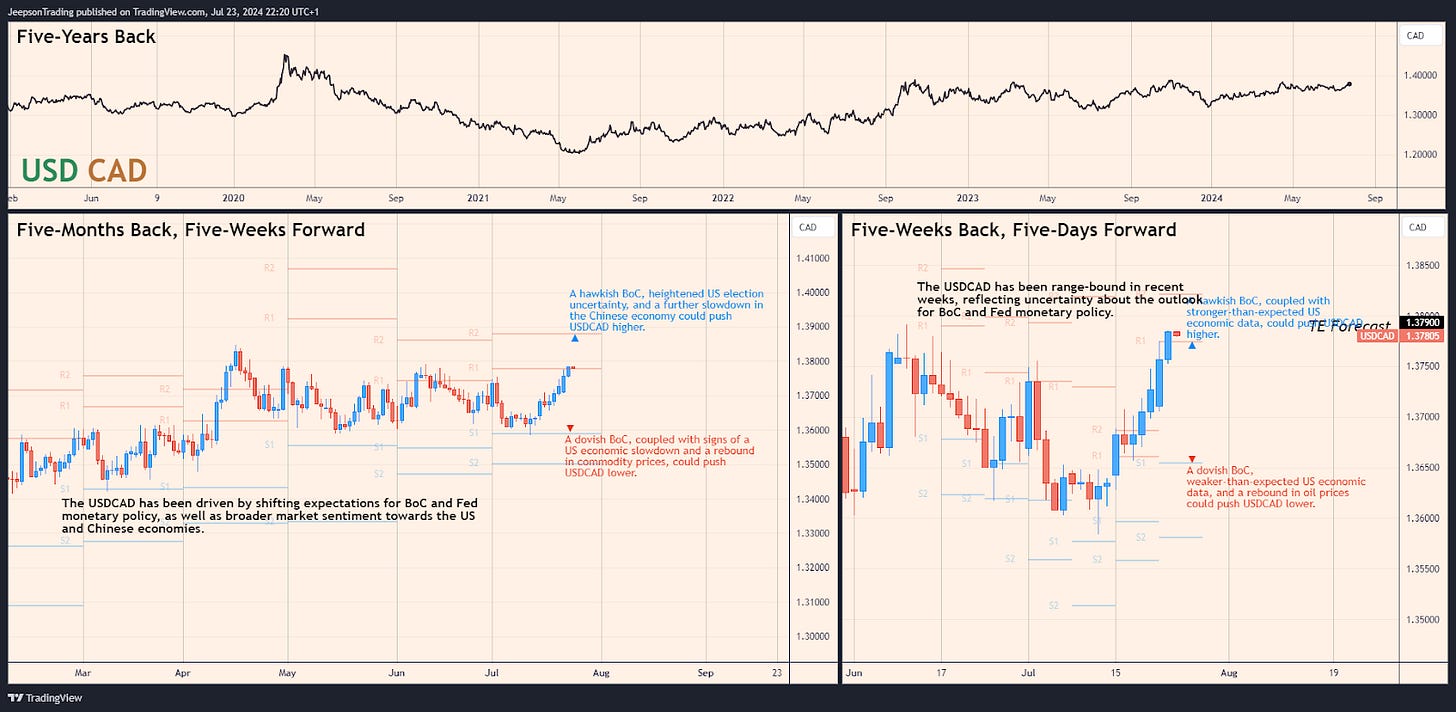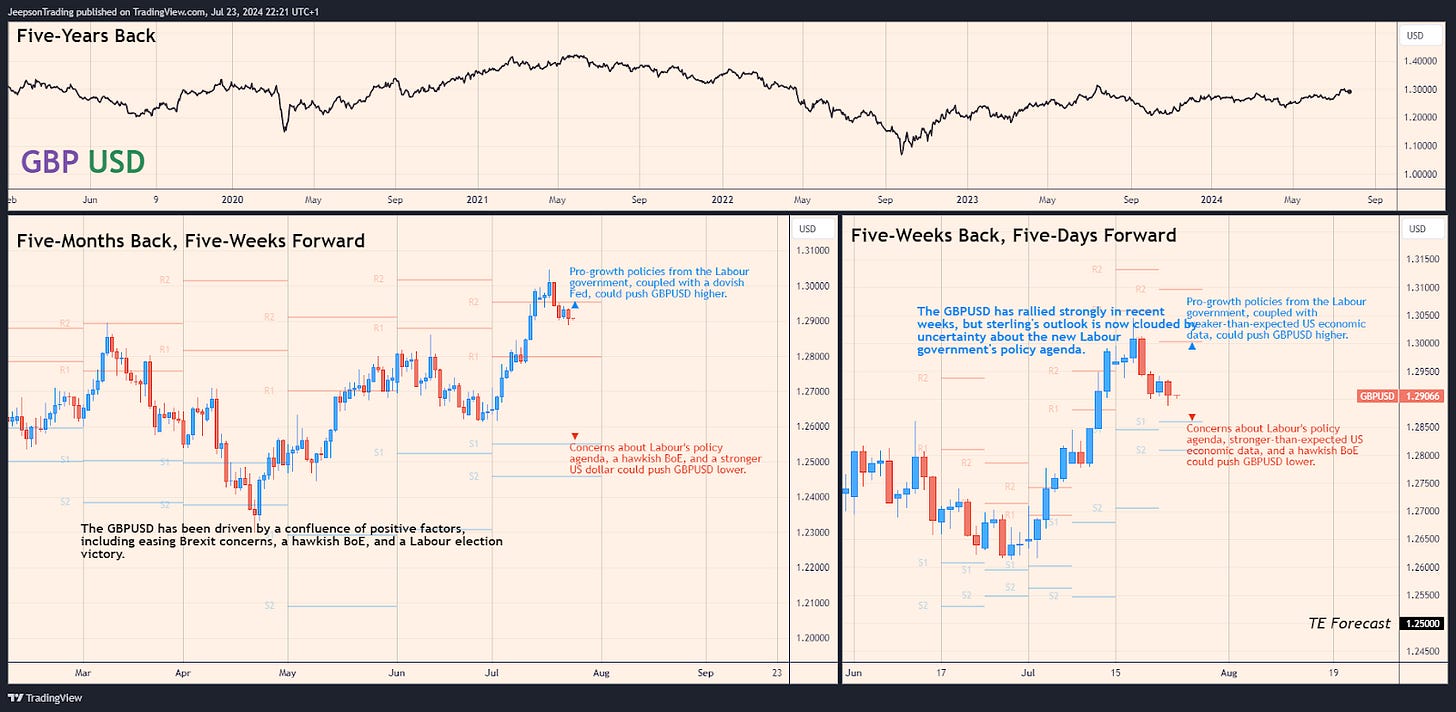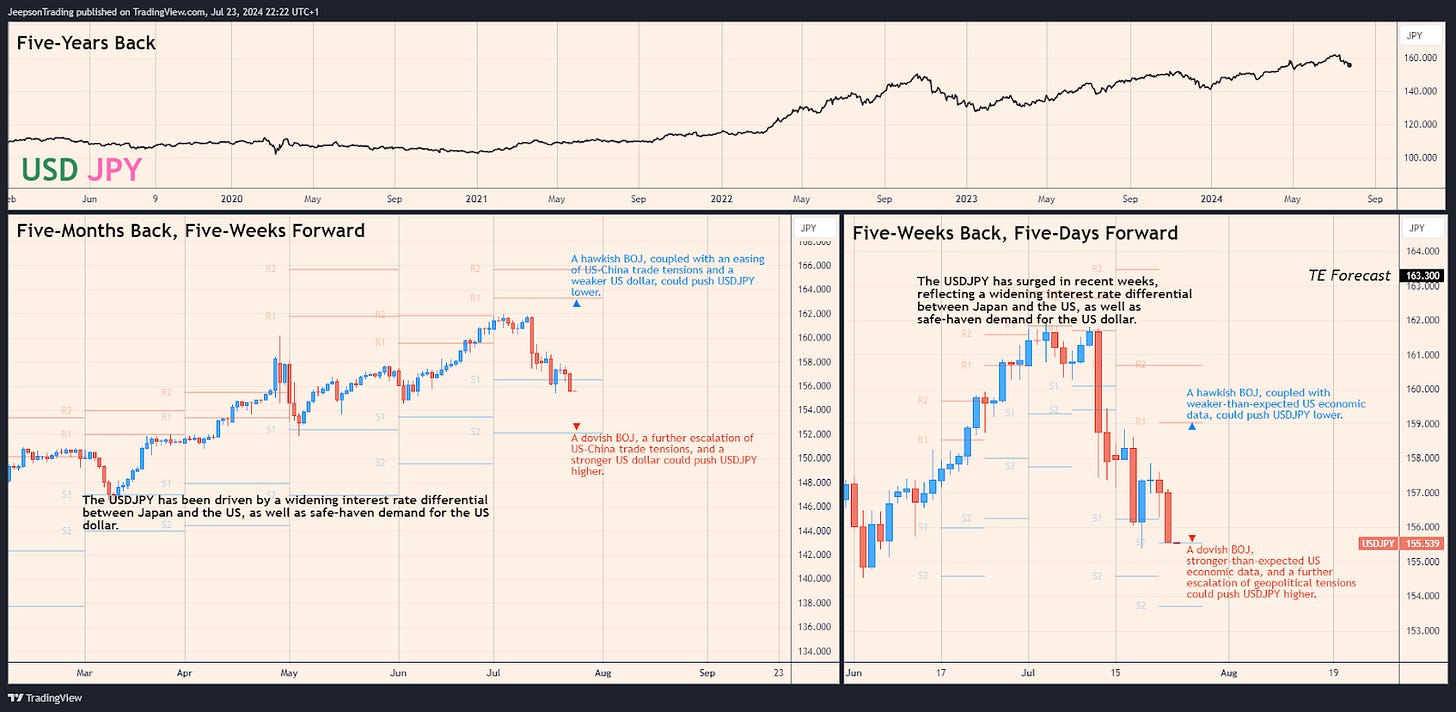Loonie Looks for Lift-Off as BoC Decision Looms
Monitor PMI's and BoC interest rate decision and Monetary Policy Report
Wednesday, 24th July, Week 30
USDCAD: Loonie Looks for Lift-Off as BoC Decision Looms
Five Weeks of Loonie Limbo: Will Rate Divergence Reignite the USDCAD Rally?
The USDCAD has been locked in a tight range between 1.36 and 1.37 for the past five weeks, as market participants weigh the outlook for diverging monetary policy between the Bank of Canada (BoC) and the Federal Reserve. This period of consolidation follows a sharp rally in April and May, which saw the pair climb from around 1.35 to a peak near 1.38 in mid-April, driven by broad US dollar strength and concerns about a Chinese economic slowdown. The loonie found some support in June as the BoC delivered a 25 basis point rate cut, but the rally proved short-lived as market participants remain cautious about the outlook for the Canadian economy. The recent decline in commodity prices, particularly oil, has also weighed on the Canadian dollar.
Summary: The USDCAD has been range-bound in recent weeks, reflecting uncertainty about the outlook for BoC and Fed monetary policy.
BoC Decision in Focus: Will Rate Cuts Fuel a Loonie Revival or Fan Inflation Fears?
The next five days will be crucial for the USDCAD, with the BoC's interest rate decision on Wednesday, 24th July (Wednesday, Week 31) in the spotlight. A second consecutive rate cut could fuel a loonie revival, particularly if the BoC signals a willingness to ease policy further in the coming months. However, if the BoC disappoints market expectations or expresses concerns about persistent inflation, the Canadian dollar could come under renewed pressure. The release of the BoC's Monetary Policy Report, also on Wednesday, will provide further insights into the central bank's thinking.
Beyond the BoC meeting, the USDCAD will be sensitive to the release of US flash PMI data on Wednesday, which could provide clues about the health of the US economy and the outlook for Fed monetary policy. The pair will also be influenced by the broader market sentiment towards the US dollar, which has been supported in recent weeks by safe-haven demand amid heightened geopolitical tensions.
Upside: A hawkish BoC, coupled with stronger-than-expected US economic data, could push USDCAD higher.
Downside: A dovish BoC, weaker-than-expected US economic data, and a rebound in oil prices could push USDCAD lower.
GBPUSD: Sterling on Shaky Ground as Labour's Policy Agenda Takes Shape
Five Weeks of Sterling Strength: Can Labour Maintain the Momentum?
The GBPUSD has been on a remarkable run over the past five weeks, surging from around 1.28 to a peak above 1.30 in the week commencing 14th July, driven by a combination of factors including easing Brexit-related uncertainty, a more hawkish Bank of England (BoE), and the Labour Party's victory in the 4th July general election. The pound's rally has been particularly impressive given the backdrop of a stronger US dollar and concerns about a global economic slowdown. However, sterling has shown signs of faltering in recent days, with the pair pulling back from its highs as market participants begin to question whether Labour can deliver on its promises to stimulate growth and investment.
Summary: The GBPUSD has rallied strongly in recent weeks, but sterling's outlook is now clouded by uncertainty about the new Labour government's policy agenda.
Labour's Policy Gamble: Will Sterling Soar or Stumble?
The next five days will be crucial for the GBPUSD, as market participants assess the new Labour government's policy agenda and its potential impact on the UK economy. The release of UK flash PMI data on Wednesday will provide a first indication of how businesses are responding to the change in government. The pair will also be sensitive to any policy announcements from the Labour government, particularly regarding fiscal policy, regulation, and Brexit.
Beyond the UK data and policy developments, the GBPUSD will be influenced by the broader market sentiment towards the US dollar and the global economic outlook. A stronger-than-expected US economy could boost the US dollar, weighing on the pound. Conversely, a weaker-than-expected global economic outlook could dampen risk appetite, supporting the US dollar and weighing on the pound.
Upside: Pro-growth policies from the Labour government, coupled with weaker-than-expected US economic data, could push GBPUSD higher.
Downside: Concerns about Labour's policy agenda, stronger-than-expected US economic data, and a hawkish BoE could push GBPUSD lower.
USDJPY: Yen Caught in the Crossfire as BOJ and Global Rates Collide
Five Weeks of Yen Weakness: Can the BOJ Stem the Tide?
The USDJPY has been on a relentless upward march over the past five weeks, surging from around 156 to a peak above 159 in early July, driven by a widening interest rate differential between Japan and the US, as well as safe-haven demand for the US dollar amid escalating geopolitical tensions. The yen's weakness has been particularly pronounced against the backdrop of a more hawkish Federal Reserve and concerns about a Chinese economic slowdown. The BOJ's decision to tweak its yield curve control policy in June did little to stem the yen's slide, as market participants remain sceptical about the BOJ's willingness to tighten monetary policy significantly.
Summary: The USDJPY has surged in recent weeks, reflecting a widening interest rate differential between Japan and the US, as well as safe-haven demand for the US dollar.
BOJ on the Brink: Will the Yen Find its Footing or Fall Further?
The next five days will be crucial for the USDJPY, with the BOJ's interest rate decision on Monday, 29th July (Monday, Week 31) in focus. If the BOJ surprises markets with a further tightening of monetary policy, the yen could stage a rebound. However, if the BOJ maintains its current stance or signals a reluctance to abandon yield curve control, the yen could weaken further. The release of the BOJ's Quarterly Outlook Report, also on Monday, will provide further insights into the central bank's thinking.
Beyond the BOJ meeting, the USDJPY will be sensitive to the release of US GDP growth for Q2 on Thursday, which could provide clues about the health of the US economy and the outlook for Fed monetary policy. The pair will also be influenced by the broader market sentiment towards the US dollar and risk appetite, which has been dampened in recent weeks by geopolitical tensions and concerns about a global economic slowdown.
Upside: A hawkish BOJ, coupled with weaker-than-expected US economic data, could push USDJPY lower.
Downside: A dovish BOJ, stronger-than-expected US economic data, and a further escalation of geopolitical tensions could push USDJPY higher.
Conclusion: Dollar's Fate Hangs in the Balance as Central Banks and Data Collide
The next five days will be a pivotal period for the forex market, with key economic data releases and central bank meetings likely to trigger significant volatility. Forex traders should closely monitor the following:
BoC interest rate decision and Monetary Policy Report: Wednesday, 24th July (Wednesday, Week 31)
US flash PMI data: Wednesday, 24th July (Wednesday, Week 31)
UK flash PMI data: Wednesday, 24th July (Wednesday, Week 31)
US GDP growth for Q2: Thursday, 25th July (Thursday, Week 31) - SEE TRADE PLAN HERE.
BOJ interest rate decision and Quarterly Outlook Report
The US dollar's performance will be heavily influenced by the interplay of these factors, with the potential for significant moves in USDCAD, GBPUSD, and USDJPY.





